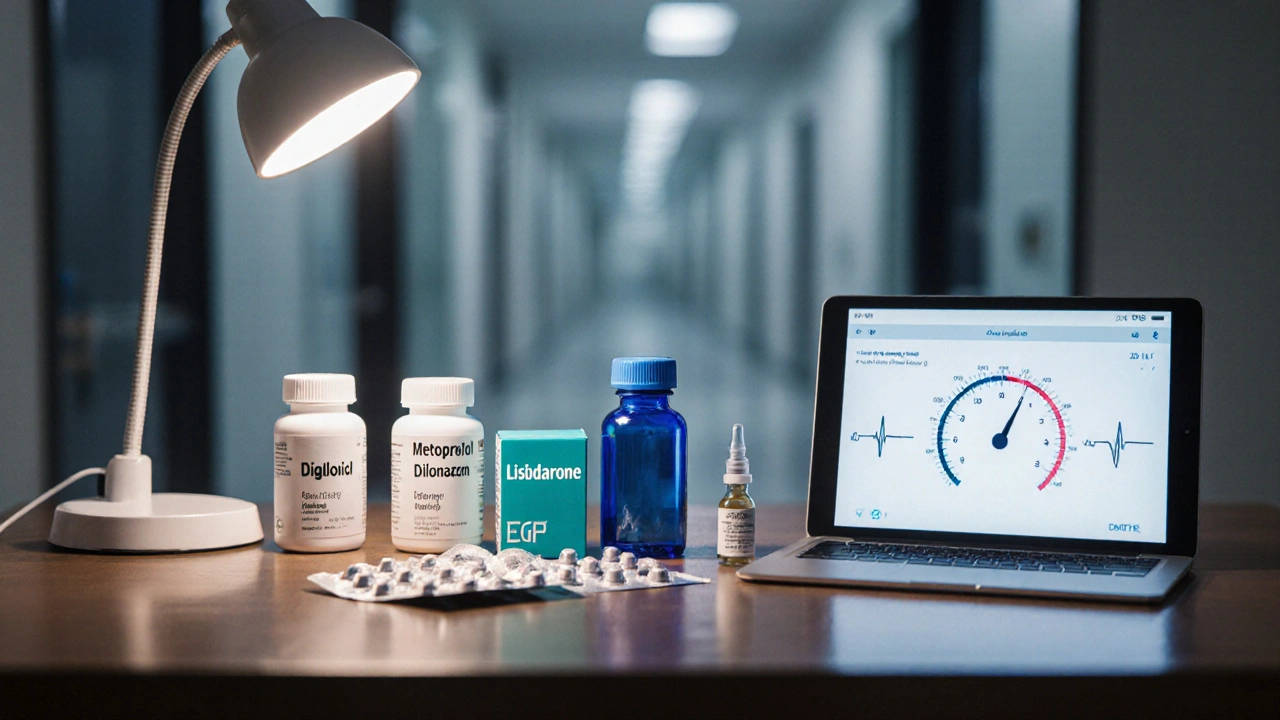Lanoxin (Digoxin) vs. Alternatives: Decision Helper
TL;DR
- Lanoxin (digoxin) is useful for certain heart‑failure and atrial‑fibrillation patients but carries a narrow therapeutic window.
- Beta‑blockers (e.g., metoprolol) and ACE inhibitors (e.g., lisinopril) are first‑line for chronic heart failure.
- Calcium‑channel blockers such as diltiazem help control rate in atrial fibrillation when digoxin is unsuitable.
- Amiodarone offers strong rhythm control but brings long‑term organ toxicity risks.
- Choosing an alternative depends on kidney function, heart‑rate targets, and drug‑interaction profile.
What is Lanoxin (Digoxin)?
Lanoxin is the brand name for digoxin, a cardiac glycoside extracted from the foxglove plant. It works by inhibiting the sodium‑potassium ATPase pump, which boosts intracellular calcium and improves myocardial contractility while slowing conduction through the atrioventricular node. In everyday practice, doctors prescribe it for two main reasons: to increase the strength of a failing heart’s pump and to control ventricular response in atrial fibrillation.
When is Digoxin Chosen?
Guidelines reserve digoxin for patients who remain symptomatic despite optimal beta‑blocker, ACE‑inhibitor, or ARB therapy. It shines in atrial fibrillationa rapid, irregular heart rhythm that can lead to stroke and heart‑failure worsening. when a low, steady heart rate is needed but other drugs cause hypotension or are contraindicated.
The drug also helps in heart failurea condition where the heart cannot pump enough blood to meet the body's demands. especially in patients with a reduced ejection fraction (≤35%). However, its benefits are modest compared with newer agents.
Key Concerns with Digoxin
The biggest headache is its narrow therapeutic index. Blood levels above 2ng/mL often produce nausea, visual disturbances, or life‑threatening arrhythmias-collectively called digoxin toxicitya spectrum of symptoms ranging from mild gastrointestinal upset to severe ventricular tachycardia.. Renal impairment, drug interactions (e.g., amiodarone, verapamil), and electrolyte imbalances (low potassium or magnesium) raise toxicity risk.

Major Alternatives to Digoxin
When digoxin isn’t a fit, clinicians turn to drug classes that address the same goals-either improving contractility or controlling rate/rhythm. Below are the most widely used alternatives.
- Beta‑blockers (e.g., metoprolol) - reduce heart‑rate and myocardial oxygen demand; first‑line for chronic heart‑failure management.
- Calcium‑channel blockers (e.g., diltiazem) - slow AV‑node conduction, useful for rate control in atrial fibrillation, especially when beta‑blockers cause bronchospasm.
- ACE inhibitors (e.g., lisinopril) - remodel the heart, lower afterload, and improve survival in systolic heart failure.
- Angiotensin‑II receptor blockers (ARBs) (e.g., losartan) - similar benefits to ACE inhibitors without cough side‑effects.
- Amiodarone - potent anti‑arrhythmic that can maintain sinus rhythm but carries thyroid, pulmonary, and hepatic toxicity risks.
Side‑by‑Side Comparison
| Drug/Class | Primary Indication | Mechanism | Renal Considerations | Major Safety Concerns |
|---|---|---|---|---|
| Digoxin | Rate control in AF & systolic HF | Inhibits Na⁺/K⁺‑ATPase → ↑ Ca²⁺ | Dose reduced if eGFR <60mL/min | Toxicity (arrhythmias, visual changes) |
| Beta‑blocker (Metoprolol) | Chronic HF, AF rate control | β₁‑adrenergic blockade → ↓ HR & contractility | Generally safe; monitor in severe COPD | Bradycardia, bronchospasm |
| Calcium‑channel blocker (Diltiazem) | AF rate control, angina | L‑type Ca²⁺ channel inhibition → slowed AV node | Use cautiously if eGFR <30mL/min | Constipation, negative inotropy |
| ACE inhibitor (Lisinopril) | Systolic HF, hypertension | Blocks conversion of Ang I → Ang II | Requires dose adjustment if eGFR <30mL/min | Cough, hyperkalemia, angio‑edema |
| ARB (Losartan) | HF, hypertension, diabetic nephropathy | Blocks Ang II AT₁ receptor | Similar to ACE inhibitors | Hyperkalemia, rare liver injury |
| Amiodarone | Rhythm control in AF, VT | Multiple channel blockade (K⁺, Na⁺, Ca²⁺) | Metabolized hepatically; dose not renal‑dependent | Thyroid dysfunction, pulmonary fibrosis, skin photosensitivity |
How to Pick the Right Alternative
Think of the decision as a checklist. Ask yourself:
- Is the patient’s kidney function impaired? If yes, avoid digoxin or lower the dose dramatically.
- Do they have bronchospastic disease? Beta‑blockers may provoke symptoms; a calcium‑channel blocker could be safer.
- Is blood pressure a concern? ACE inhibitors or ARBs can treat both hypertension and heart failure simultaneously.
- Do they need rhythm control (maintain sinus rhythm) rather than just rate control? Amiodarone is powerful but should be a last resort.
- Are there any interacting medicines on their list? For example, amiodarone raises digoxin levels, while verapamil can cause bradycardia with beta‑blockers.
Putting these answers together often points to a combination: a beta‑blocker plus an ACE inhibitor for most chronic HF patients, reserving digoxin for those who stay tachycardic despite optimal dosing.
Practical Checklist for Clinicians
- Confirm indication - rate control vs. inotropic support.
- Check eGFR and electrolytes before starting or adjusting digoxin.
- Review current meds for known digoxin interactors (e.g., amiodarone, quinidine, verapamil).
- Set target serum digoxin level: 0.5-0.9ng/mL for heart‑failure patients.
- If toxicity suspected, stop the drug and consider digoxin‑specific antibody fragments.
- When switching, taper beta‑blocker or calcium‑channel blocker gradually to avoid rebound tachycardia.
Frequently Asked Questions
Can I stop digoxin abruptly?
Stopping suddenly may cause a rebound increase in heart rate and worsen heart‑failure symptoms. Tapering over a week while monitoring heart rate and rhythm is safer.
What makes amiodarone a “last‑resort” drug?
Its efficacy is high, but the price is long‑term organ toxicity - thyroid, lung, liver, and skin. These side‑effects can appear months to years after therapy starts, so clinicians reserve it for patients who failed or cannot tolerate other agents.
Is digoxin still recommended for modern heart‑failure therapy?
Guidelines list it as a *class IIa* option when patients remain symptomatic despite beta‑blocker, ACE‑inhibitor/ARB, and mineralocorticoid‑receptor antagonist therapy. It is not first‑line.
How does renal impairment affect digoxin dosing?
Because about 70% of digoxin is excreted unchanged in urine, an eGFR<60mL/min warrants a 25-50% dose reduction, and careful level checks every 1-2weeks after any adjustment.
When should a beta‑blocker be preferred over digoxin for atrial fibrillation?
If the patient has preserved blood pressure and no severe asthma or COPD, beta‑blockers provide better rate control, lower mortality, and no risk of narrow‑therapeutic‑index toxicity.
In short, Lanoxin alternatives cover a spectrum of mechanisms. By matching the patient’s kidney function, comorbidities, and drug‑interaction profile to the right class, you can often achieve safer, more effective control of heart‑failure symptoms or atrial‑fibrillation rate.


Nicole Povelikin
October 3, 2025 AT 10:38First off, i think the whole digoxin hype is overrated – it's just another pharma ploy. The narrow therapeutic window makes it a risky choice for most patients, especially when we have safer beta‑blockers. Plus, the article glosses over the fact that toxicity can sneak up on anyone with even a mild kidney issue. Honestly, why bother when there are alternatives with litte side‑effects?
Michelle Weaver
October 6, 2025 AT 23:51Digoxin has a respectable place in cardiology but its use should be highly selective. The drug improves contractility by inhibiting Na⁺/K⁺‑ATPase which raises intracellular calcium. It also slows AV‑node conduction which can be useful in rate control for atrial fibrillation 😊. However the therapeutic index is razor thin and requires careful dosing especially in renal impairment 😊. Many clinicians reserve it for patients who cannot tolerate beta‑blockers or ACE inhibitors 😊. The evidence suggests modest mortality benefit in selected heart‑failure populations 😊. For patients with normal kidney function a standard dose may be appropriate but close monitoring is essential 😊. In the presence of low potassium or magnesium the risk of arrhythmias skyrockets 😊. Drug interactions with amiodarone, verapamil, and certain antibiotics can dramatically raise serum levels 😊. The recommended target serum concentration is 0.5‑0.9 ng/mL for most indications 😊. Doses should be reduced by 25‑50 % in patients with eGFR below 60 mL/min/1.73 m² 😊. In patients with atrial fibrillation who are elderly the risk‑benefit ratio often favors beta‑blockers 😊. Lifestyle factors such as diet rich in high‑potassium foods can mitigate toxicity risk 😊. Regular ECG and serum level checks are part of safe digoxin stewardship 😊. Ultimately the decision hinges on individual patient characteristics and the availability of alternative therapies 😊. Clinicians should also educate patients on signs of toxicity such as visual disturbances and nausea 😊.
John Keough
October 10, 2025 AT 13:04I get why some docs keep digoxin in their toolbox; it can be a lifesaver when other meds fail. That said, the article could have highlighted more recent data on SGLT2 inhibitors that actually improve outcomes in heart failure. If you have a patient with good renal function and stable rhythm, a low‑dose beta‑blocker might be a cleaner option. Still, the drug’s unique mechanism makes it worth knowing.
Graham Smith
October 14, 2025 AT 02:18While your enthusiasm is appreciated the previous comment contains several punctuation errors. Specifically “beta‑blocker” should be hyphenated and “SGLT2” does not require a space.
Jeremiah Morgan
October 17, 2025 AT 15:31Indeed, the therapeutic niche for digoxin remains quite specific and clinicians must weigh the benefits against the narrow safety margin. In practice, careful titration and periodic serum level checks mitigate most concerns. Moreover, patient education on dietary potassium can further reduce toxicity risk. With diligent monitoring, digoxin can still contribute positively to heart‑failure management.
nina greer
October 21, 2025 AT 04:44One must acknowledge the inherent pharmacodynamic elegance of cardiac glycosides.
Montague Tilmen
October 24, 2025 AT 17:58Frankly, this whole discussion reeks of foreign medical guidelines trying to dictate American practice. Our own cardiology societies have long recognized digoxin’s role and we shouldn’t be swayed by overseas hype.
Clarise Wheller
October 28, 2025 AT 07:11I see your point but let’s keep the focus on patient outcomes rather than national pride. Digoxin does have a place when used responsibly.
Riley Fox
October 31, 2025 AT 20:24Ah, the paradox of a drug that both heals and harms-what a cosmic irony!; It reminds us that medicine is as much art as science;; Digoxin’s narrow window is a metaphor for life’s fragile balance 😊; Yet we persist, seeking equilibrium in the chaos 😊; The heart, after all, beats to the rhythm of both certainty and uncertainty 😊;
Vikas Kale
November 4, 2025 AT 09:38Indeed, the pharmacokinetic profile of digoxin, characterized by a biphasic distribution and a volume of distribution approximating 7 L/kg, mandates vigilant therapeutic drug monitoring (TDM). When co‑administered with P‑glycoprotein inhibitors, the area under the curve can increase exponentially, precipitating arrhythmogenic events. Thus, integrating pharmacogenomic data, especially ABCB1 polymorphisms, can refine dose optimization. 😊
Deidra Moran
November 7, 2025 AT 22:51What the article fails to mention is how the pharmaceutical lobby subtly influences guideline committees. There’s a concerted effort to keep older drugs like digoxin off the radar while promoting newer, more profitable molecules. It's all part of a larger agenda to control prescriptions and maximize revenue.
Zuber Zuberkhan
November 11, 2025 AT 12:04I understand the concerns about industry influence, but we must also recognize the genuine clinical benefits digoxin offers to certain patients. A balanced view that acknowledges both the strengths and the potential conflicts is essential for informed decision‑making.
Tara Newen
November 15, 2025 AT 01:18Let’s be clear: the data from our own national studies consistently show better outcomes with digoxin in specific subpopulations compared to foreign trials. Ignoring this evidence would be a disservice to American patients.